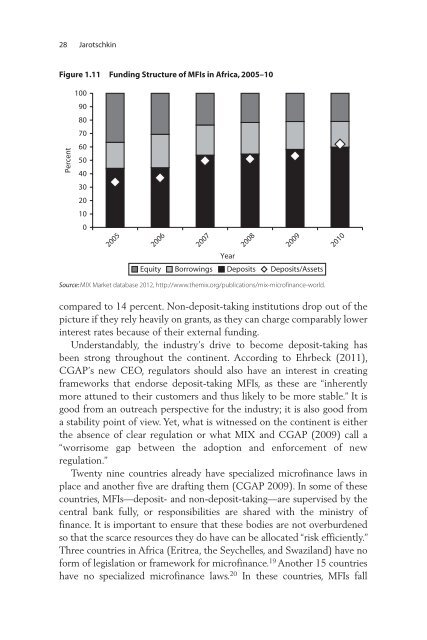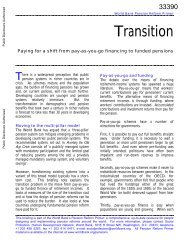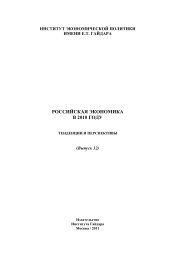Financial Sector Development in Africa: Opportunities ... - World Bank
Financial Sector Development in Africa: Opportunities ... - World Bank
Financial Sector Development in Africa: Opportunities ... - World Bank
Create successful ePaper yourself
Turn your PDF publications into a flip-book with our unique Google optimized e-Paper software.
28 Jarotschk<strong>in</strong><br />
Figure 1.11 Fund<strong>in</strong>g Structure of MFIs <strong>in</strong> <strong>Africa</strong>, 2005–10<br />
Percent<br />
100<br />
90<br />
80<br />
70<br />
60<br />
50<br />
40<br />
30<br />
20<br />
10<br />
0<br />
2005<br />
2006<br />
2007<br />
2008<br />
2009<br />
2010<br />
Year<br />
Equity Borrow<strong>in</strong>gs Deposits Deposits/Assets<br />
Source: MIX Market database 2012, http://www.themix.org/publications/mix-microf<strong>in</strong>ance-world.<br />
compared to 14 percent. Non-deposit-tak<strong>in</strong>g <strong>in</strong>stitutions drop out of the<br />
picture if they rely heavily on grants, as they can charge comparably lower<br />
<strong>in</strong>terest rates because of their external fund<strong>in</strong>g.<br />
Understandably, the <strong>in</strong>dustry’s drive to become deposit-tak<strong>in</strong>g has<br />
been strong throughout the cont<strong>in</strong>ent. Accord<strong>in</strong>g to Ehrbeck (2011),<br />
CGAP’s new CEO, regulators should also have an <strong>in</strong>terest <strong>in</strong> creat<strong>in</strong>g<br />
frameworks that endorse deposit-tak<strong>in</strong>g MFIs, as these are “<strong>in</strong>herently<br />
more attuned to their customers and thus likely to be more stable.” It is<br />
good from an outreach perspective for the <strong>in</strong>dustry; it is also good from<br />
a stability po<strong>in</strong>t of view. Yet, what is witnessed on the cont<strong>in</strong>ent is either<br />
the absence of clear regulation or what MIX and CGAP (2009) call a<br />
“worrisome gap between the adoption and enforcement of new<br />
regulation.”<br />
Twenty n<strong>in</strong>e countries already have specialized microf<strong>in</strong>ance laws <strong>in</strong><br />
place and another five are draft<strong>in</strong>g them (CGAP 2009). In some of these<br />
countries, MFIs—deposit- and non-deposit-tak<strong>in</strong>g—are supervised by the<br />
central bank fully, or responsibilities are shared with the m<strong>in</strong>istry of<br />
f<strong>in</strong>ance. It is important to ensure that these bodies are not overburdened<br />
so that the scarce resources they do have can be allocated “risk efficiently.”<br />
Three countries <strong>in</strong> <strong>Africa</strong> (Eritrea, the Seychelles, and Swaziland) have no<br />
form of legislation or framework for microf<strong>in</strong>ance. 19 Another 15 countries<br />
have no specialized microf<strong>in</strong>ance laws. 20 In these countries, MFIs fall







